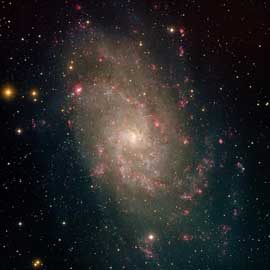
Spiral galaxy M33 has a small, compact stellar nucleus. The masses of such nuclei scale to the mass of the host galaxy. Click to view a larger image.
Courtesy Travis Rector / M. Hanna / NOAO / AURA / NSF.
Over the past decade, astronomers have established the remarkable fact that supermassive black holes have a scaling relationship with their host galaxies. The more massive the black hole, the more massive is the galaxy's spheroidal component (either an entire elliptical galaxy or the central bulge of a spiral galaxy). This M-sigma relation tells astronomers that the evolution of galaxies and their supermassive black holes are intertwined (see the cover story of the July issue of S&T).
Until now, this relation only applied to large and medium-size galaxies, where astronomers have found supermassive black holes. But in a paper to appear in the June 10, 2006, issue of the Astrophysical Journal Letters, Laura Ferrarese (Herzberg Institute of Astrophysics, Canada) and 11 colleagues say it extends all the way down to very-low-mass galaxies, albeit in a modified form.
The team studied 100 elliptical galaxies, from giant to dwarfs, imaged as part of a Hubble Space Telescope deep survey of the Virgo Cluster. Coupled with spectroscopic observations at several telescopes on Arizona's Kitt Peak, they found that the masses of compact stellar nuclei, which are found almost exclusively in the fainter galaxies, share the same scaling relationship with their host galaxies as do supermassive black holes. They also found that the nuclei of two low-mass galaxies in our Local Group, M33 in Triangulum and M110 (NGC 205), one of the Andromeda Galaxy's satellites, also follow the same relation. Neither galaxy shows evidence of a supermassive back hole.

This graph plots the mass of a galaxy's central, compact object (either a supermassive black hole or a stellar cluster) versus the galaxy's spheroidal component (either an entire elliptical galaxy or the bulge of a spiral galaxy). Click to view a larger image.
Source: Laura Ferrarese.
The results suggest that all galaxies may form dense, central objects — either a supermassive black hole or a compact stellar cluster — that contain about 0.2% of the galaxy's spheroidal mass. The team speculates that compact stellar nuclei could be "failed black holes" — systems in which the central mass failed to collapse gravitationally all the way down to nature's ultimate abyss. The same conclusion has received further support by the work of Elizabeth Wehner and William Harris (McMaster University, Canada) and Joern Rossa (Space Telescope Science Institute).
"We were quite excited when we found this result, as I think it adds another important piece of information to the puzzle," says Ferrarese. "Compact nuclei are as fundamental a constituent of galaxies as supermassive black holes. Explaining how they formed might hold important clues as to the mechanisms by which the galaxies themselves formed."
 0
0
Comments
You must be logged in to post a comment.